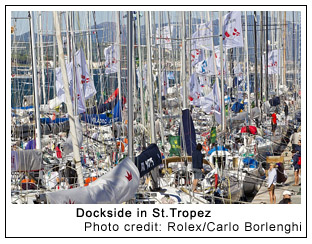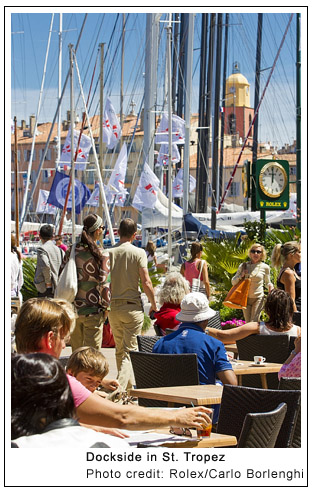|
Giraglia Rolex Cup
St.Tropez, France / Genoa, Italy
STRONG WINDS DELAY START
 With the strong, boisterous mistral breeze which consumed Saint-Tropez this morning not subsiding in the early afternoon, the race committee raised the A underneath AP flag signal at 14:24 CEST to confirm the cancellation of today’s inshore racing at the Giraglia Rolex Cup. After gusts had reached a maximum of 40 knots today, calmer winds are predicted for tomorrow’s inshore racing, which should ensure that the crews have the opportunity to hone their preparations for Wednesday’s commencement of the offshore race. With the strong, boisterous mistral breeze which consumed Saint-Tropez this morning not subsiding in the early afternoon, the race committee raised the A underneath AP flag signal at 14:24 CEST to confirm the cancellation of today’s inshore racing at the Giraglia Rolex Cup. After gusts had reached a maximum of 40 knots today, calmer winds are predicted for tomorrow’s inshore racing, which should ensure that the crews have the opportunity to hone their preparations for Wednesday’s commencement of the offshore race.
The lure of the Giraglia Rolex Cup
One of the most striking facets about the Giraglia Rolex Cup, is the sheer number of crews that return year after year to participate in this historic competition. The appeal of the event can be addictive. The more a crew becomes familiar with the course, the greater their desire to return. The difficulties and tribulations that crews encounter during the competition soon subside with the joy of having completed the event. The Giraglia Rolex Cup can be a gruelling and compelling competition with most yachts facing at least a night at sea and ever-changing weather conditions. Today’s strong winds were a poignant reminder of this.
It is not just setting and defeating personal targets that draws sailors to race. With 58 past editions, the event has a rich pedigree and legend. Initially created to help repair French and Italian relations following the Second World War and launch a serious sailing regatta in the Mediterranean, the competition has become an iconic event and particularly cherished by the French and Italian sailing communities. Around 80% of the fleet still comes from these two countries. Many of these crews have had friends and relatives who have taken part in the event and passed down tales of great adventure and solidarity.
Alberto Patrone and Francesco Da Monte of the Vismara 34 Manida (ITA), one of the smallest yachts in the competition, are fully absorbed by the event’s appeal. “We have a lot of experience here, having done the Giraglia about twenty times,” explains Patrone. “Weather-wise, there is always a question mark regarding how the event may go. We prefer the lights winds,” jokes Patrone, “obviously not like today, when we are rooted to the dock.” Patrone continues: “Being here in Saint-Tropez is very special, in particular the ambience and the feeling that the event is about to start.” For the Genoa-based crew, the race is somewhat a journey home given that the offshore race finishes in the Ligurian city. And despite helming one of the competition’s smaller yachts, Patrone is bullish about the team’s chances: “We always start with the ambition of winning - it is our objective.” The race stretches the crew of seven’s resources: “We rest the minimum possible,” confirms Da Monte, “we always give everything we have and then think about resting when we arrive!”
Roberto Bruno, owner and helmsman of the Canard 41 Aurora (ITA), is equally inspired by this 243-nautical mile marathon: “The event is profoundly ingrained in my DNA as a sailor and I consider it along with the Rolex Middle Sea Race as the most exciting event of the season.” Bruno clearly remembers when he was first drawn to the event: “I was 16 years old waiting on the dock for the boats to arrive, one day imagining I could climb aboard. Two years later, I got the opportunity and have since participated in more than 20 editions on various boats between 10-12 metres.”
 This evening witnesses the celebrated Giraglia Rolex Cup Crew Party, at the Citadelle in Saint-Tropez. Bruno enjoys the festive atmosphere at the beginning of the competition, a chance for the teams to mingle and mix: “The Giraglia is an event within an event, the festive and carefree atmosphere is expressed in this marvellous party before this transforms itself into a healthy spirit of competition as the yachts compete against each other from the smallest 10m boat to the largest Maxi.” This evening witnesses the celebrated Giraglia Rolex Cup Crew Party, at the Citadelle in Saint-Tropez. Bruno enjoys the festive atmosphere at the beginning of the competition, a chance for the teams to mingle and mix: “The Giraglia is an event within an event, the festive and carefree atmosphere is expressed in this marvellous party before this transforms itself into a healthy spirit of competition as the yachts compete against each other from the smallest 10m boat to the largest Maxi.”
The contagious appeal of the competition has also inspired non-Italian and French crews such as Pieter Houting’s Peak (NED), a Swan 65 Ketch. “This is the seventh time we are participating,” explains Houting, whose team are all close friends. “After each race, we fill in a book where we write every experience, therefore it becomes easier and easier to prepare for the following event.”
The crew of Peak enjoy the gradual build up to the offshore race. “The coastal races are wonderful for us in preparing for the long race. There is then a lot of stress on the evening before the long race. For us, as a non-racing boat, the main ambition is to come home safe and sound.” During years when Houting and his crew are unable to compete in the complete regatta circuit, they are often restricted to entering only one race. Such is the stature of the Giraglia, this is the one they always choose to compete in.
Houting’s own relationship with the Giraglia began many years ago: “I started when I was very young sailing on a 42-ft French boat. I sailed on the old circuit from Toulon to San Remo many times. I remember one year there was a tremendous storm and that experience is still in my system.” As for many sailors here on the dockside in Saint-Tropez, the Giraglia Rolex Cup is at the core of Houting’s own sporting heritage.
From A to B
Preparation for an offshore race like the Giraglia Rolex Cup requires long hours and strategic thinking, particularly for the navigators, who carry out detailed planning and forensic studying of meteorological charts ahead of the event. Nat Ives, navigator on the 60-ft Mini Maxi Jethou (GBR), is focused on the challenge and for a fully-charged week: “We start looking at the race course and possible scenarios from weeks in advance before getting into the race area and looking at the long range forecast for the offshore race.”
Ives is all too aware that whilst the pre-event planning phase is important, his job requires him to adapt quickly to the potentially changing conditions of an offshore race: “You have a weather forecast at the start and then the reality of the conditions might immediately change. You have to start rethinking your plans as well as factor in the competition and what they are doing. Then there are the unexpected things. We might break a sail which means we can’t sail a specific angle or as fast as we want. You are always updating.”
“I am not on the watch system,” continues Ives, “my timetable is more dictated by the weather changes and the times that these become available. However, I don’t expect to get much rest.”
As navigator, Ives is required to keep abreast of the continuing technological advancements and improvements available: “These days it is all about technology, although the irony is that we get more and more things to make it easier but it actually gives us more things to think about. We’ve got a lot of access to information, with a computer running all of the theoretical routing. I log every bit of sailing that we do and we develop our polars and performance profile. From that we learn about the sail crossovers and are constantly relying on technology.”
One of the busiest days for the crew is during the changeover from the inshore races to the offshore race. “We have to get food and drink onboard,” continues Ives, “as well as load the life rafts and some of the rope changes. The hardest choice for us is deciding which sails go onboard.”
“Managing the pressure,” is what Ives believes is the most difficult element of the competition for a navigator, “I’m the font of information and responsible for feeding this to the tactician and the final strategy will be his say. On an offshore race the guys are racing hard and we’ve spent a lot of money, time and effort and it comes down to these tactical decisions.”
And when asked about what drew him into a career as a navigator, Ives jokes: “It is too wet up in the bow, I just tried to figure out how I could do the least amount of manual labour and still go sailing!”
In the build up to the Giraglia Rolex Cup offshore race, regattanews.com will continue to assess the crucial role of the navigator.
How To Follow Event
Further information on the Giraglia Rolex Cup may be found at www.giragliarolexcup.com. To receive daily reports and to download high-resolution images, copyright free for editorial purposes, register online at www.regattanews.com
TOP
|